Our Venice correspondent Sara Scarpa travels west to spend a weekend in Verona, the city of love and opera set in the land of wines
Photos by Iain Reid
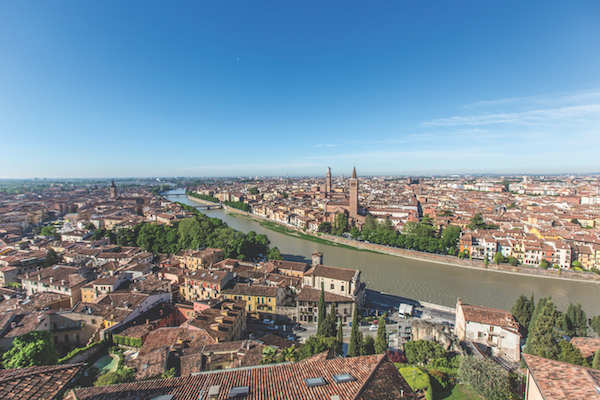
When you visit Verona, you will soon understand why this city is the perfect setting for the world’s greatest love story. Beautiful piazzas, winding streets, the castle, the city walls and the river hugging its curved banks all create a special and very Italian romantic atmosphere. But Verona is not only the Città dell’Amore – and therefore one of the best destinations for a romantic weekend – it is also (after Rome) the Italian city with the best-preserved Roman remains. Remarkable traces still remain today: the Arena; the Gavi Arch at Porta Borsari (the ancient entrance to the city); the archaeological site at Porta Leoni, ancient villas and mosaics located below street level. Indeed, its Roman heritage is such that in 2000 Verona was inscribed on the UNESCO World Heritage List.
Thanks to its strategic position between the valley of the River Adige and the Pianura Padana, Verona has been an important city for millennia. However, after the Romans arrived its importance grew so much that it became one of the most important cities in northern Italy. After the fall of Rome it was dominated by different populations before finally, in the 12th century, acquiring a status of autonomy. The city experienced further periods of expansion in the 13th and 14th centuries under the Scaliger rule and it was then that it achieved its greatest splendour with regards to art and culture. Under Cangrande I della Scala (1308-28) Verona conquered Padua and Vicenza. Another long period of prosperity and peace reigned after the city submitted to Venice in 1405, and this lasted until Napoleon’s arrival in 1797.
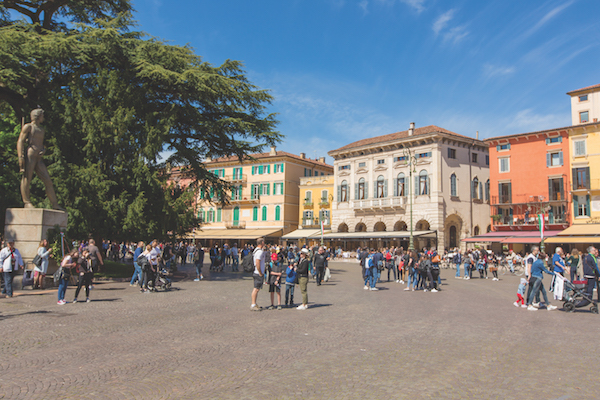
A walk in the city
Just a kilometre and a half away from the railway station of Porta Nuova (which is linked by shuttle bus service to the airport) Piazza Bra was the starting point for our walk in the city. The square is a harmonious collage of different architectural styles and periods – the gigantic Arena, the Neoclassical Palazzo Barbieri, the monumental Gran Guardia, the Fontana delle Alpi (the fountain which commemorates the twinning between the city of Verona and Munich), and the Liston with its noble palaces.
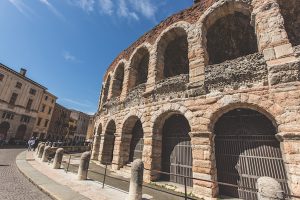
Dominating the square, the Arena is the monument par excellence of the city. Built in the 1st century AD, it is the third largest amphitheatre in Italy, after the Colosseum in Rome and the Amphitheatre of Capua. Once the stage for gladiator fights, it is today the stage for the open-air opera festival and other music concerts that take place here every summer and attract thousands of visitors.
From Piazza Bra we walked to Via Mazzini, the elegant street full of shops and boutiques, which took us to Juliet’s house. Thousands of letters from across the globe addressed to “Juliet, Verona” have been arriving for many years to this northern Italian city linked with Shakespeare’s 16th-century romantic tragedy Romeo and Juliet.
Sorrowful letters, sad tales of love, honest expressions of feelings that still strike a chord to many, and the exchange of feelings is reciprocated by a team of Juliet secretaries, led by Giovanna Tamassi (the daughter of the founder of the Juliet Club), who have been responding to each letter that has been received since 1972!
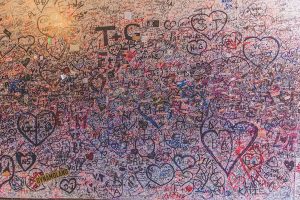
Although Shakespeare borrowed heavily and embellished the original tale by Arthur Brooke, his name is now forever linked to the city, and to many this is the initial draw in planning a visit to this Veneto jewel. But although there is harmless curiosity in taking up the Shakespeare trail, the city is awash with non-fictional history, art, culinary delights and plenty of impressive architecture.
Tradition has it that the 13th-century villa in Via Cappello, in the centre of Verona, was Juliet’s residence. Even though Juliet is a fictional character and it is likely that the villa was offered as her residence only at the end of the 19th century (perhaps to save the myth of the legendary heroine and to seize a commercial opportunity) thousands of loving couples fascinated by the story of the star-crossed Romeo and Juliet come and visit it every day.
Passing under the arch of the entrance you cannot miss the hundreds of pieces of paper stuck to the wall alongside decades of loving inscriptions penned into the wall with amorous couples’ names and their declarations of love.
From there you will reach the small courtyard with Juliet’s famed balcony. If you close your eyes you might be able to imagine the romantic balcony scene from Romeo and Juliet, though the magical atmosphere will be probably soon cut by some visitor taking selfies while rubbing the right breast of the bronze statue of Juliet for good luck in love.
We stopped to take a photo of the courtyard but due to the fact that the place was packed with people we skipped the visit of the interior of the house. There you will find a small museum with interesting frescoes, engravings and ceramics, together with a display of the costumes of Romeo and Juliet, Juliet’s bed and some of the furniture used in Franco Zeffirelli’s film adaptation of the story in 1968. Even though the couple never existed, Shakespeare never visited Verona, and the famous balcony (which is actually a sarcophagus) was added in the 20th century, I still recommend paying it a visit. In fact, in spite of all the commercial construction, the powerful love story lives on. I found it fascinating to look at the many couples who went there from around the globe to live the fantasy, and reading some of the love declarations covering the walls made me think about the fact that, despite the fiction surrounding me, people’s feelings were real.
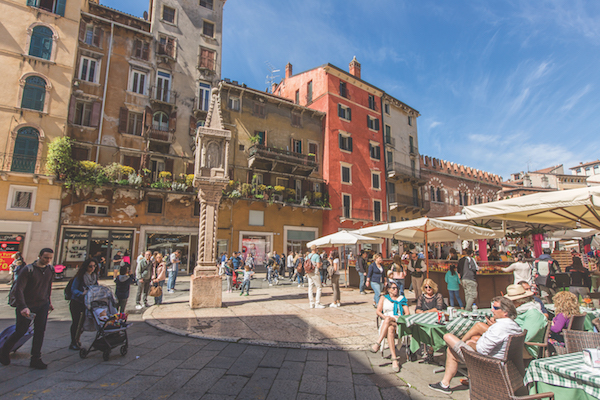
Bustling market
Leaving Juliet’s house with a dreamy image of the famous couple declaring their love to one other I wanted to get closer to the real city life, so I headed to Piazza delle Erbe to browse the many stalls within this bustling market. The market is a real mixed bag covering everything from arts and crafts, local fruit and vegetables, local wines and souvenirs. The produce is of good quality, benefitting from the areas surrounding Verona being some of the richest agricultural lands in Italy. The square has been the social, economic and religious heart of the city for centuries. In Roman times it was the Forum; in the communal period it was the seat of the political power, and under the Scaliger family it was the centre of arts and trade. Today it houses the lively market which takes place daily from Monday to Saturday.
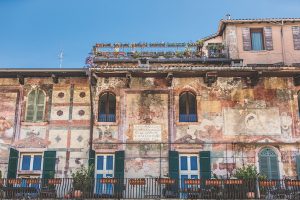
Surrounding the market, you have a choice of a number of café-bars and so after picking up some local produce we opted for Casa Mazzanti Caffè, sipping a Spritz all’ Aperol to enjoy in the sunshine while watching the world pass by.
The architecture in Piazza delle Erbe is fascinating as you get a real sense of the different historic periods and styles that have shaped the city. On the right, coming from Via Mazzini, stands the 13th-century Palazzo della Ragione, which was the political centre of the city. On the short northwestern side of the Piazza stand the baroque Palazzo Maffei and the ancient Torre del Gardello. At the corner with Via Pellicciai stands the impressive Domus Mercatorum, and finally, on the long side of the piazza (between Corso Sant’Anastasia and Casa dei Giudici and Arco della Costa), stand the 16th-century frescoed Mazzanti Houses. In the middle of the square is the Fountain of the Madonna Verona and in front of Palazzo Maffei the column with Saint Mark’s lion, standing in testimony to Venetian dominion.
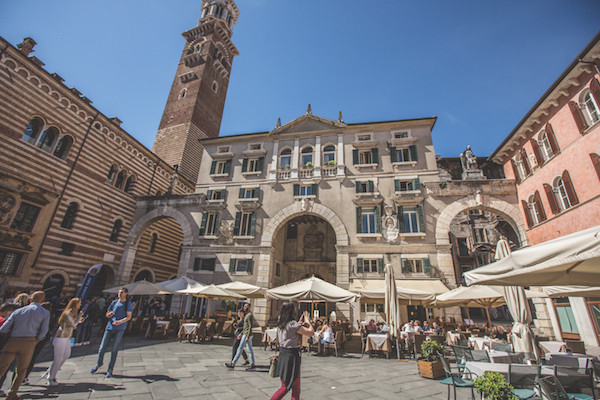
Safe passage
We then passed under the medieval Arco della Costa between the Domus Nova and the Palazzo della Ragione. In Venetian times the walkaway provided a safe passage for judges and magistrates to go from their residence to the city court without having to go through the street and therefore without having to mingle with common or corrupt people. The arch owes its name to a whale rib which has been hanging under it for centuries. The bone could be a relic from the Holy Land or brought back by soldiers fighting at the Battle of Lepanto; a fossil from the hills near Verona; or, more likely, a sign for a pharmacy which used to be situated on the corner of the square. No one knows for sure, and even though there are many theories about it, it remains a mystery. According to legend, the bone should fall on the first innocent or just person to walk underneath!
The arch is the entrance to the elegant Piazza dei Signori and to Torre dei Lamberti. From the 84-metre-high tower, the highest in the city, we were able to see the Roman perimeter of the city and enjoy a breathtaking view. If you think the 368 steps might prevent you from fully enjoying the panorama you can be whisked up by a glass lift instead.
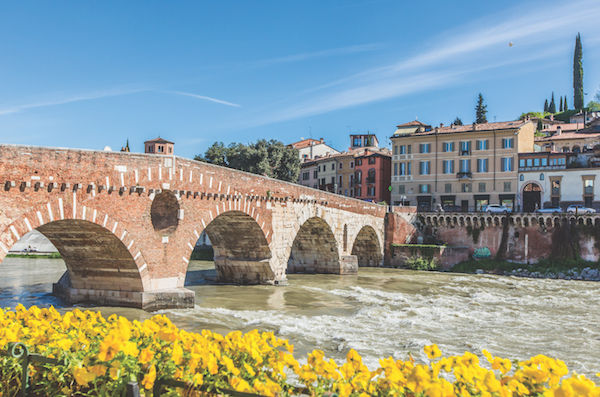
A thoughtful Dante
On returning to lower ground in the Piazza we were greeted by the imposing statue of a thoughtful Dante (the Florentine poet spent years in Verona with Bartolomeo and Cangrande I della Scala). The beautiful square is surrounded by the Palazzi della Ragione, Palazzo del Capitano, Palazzo del Governo and Loggia del Consiglio and nowadays is a meeting point for locals away from the busier Piazza delle Erbe, and is also popular with children burning off some excess energy.
Walking in the direction of the Church of Santa Maria Antica to admire the impressive Arche Scaligere (the Scaliger Tombs), is a group of Gothic funerary monuments celebrating the della Scala family, who ruled Verona from the 13th century to the late 14th century. The most majestic monument is the equestrian statue of Cangrande I. The leader of the Ghibelline faction was the ruler of Verona from 1308 to 1329. He was a successful conqueror (he took control of Vicenza, Padua and Treviso) but also a politician and a generous patron. Dante dedicated to him the first canto of the Paradiso.
Spectacular monuments
Distracted by the spectacular monuments, we almost missed the large medieval building which is believed to be Romeo’s house. The Montecchi family really existed and lived in this area of Verona, perhaps in this house, which is now private and therefore cannot be visited. On the beautiful Gothic façade an inscription recalls Shakespeare’s Romeo and Juliet – “Tut, I have lost myself, I am not here: This is not Romeo, he’s some other where.” (Act 1, Scene 1).
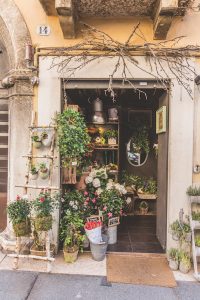
If you are disappointed in not being able to visit Romeo’s house, do not fret as stopping for some food and wine will definitely cheer you up. The Osteria Al Duca is a typical Veronese restaurant located on the ground and first floor of the building and it comes with a charming and welcoming atmosphere. We decided to stop here to take a break before continuing with our walk and we really enjoyed the Penne Romeo followed by a tender beef stewed in Amarone red wine sauce with polenta.
After lunch we headed to the Basilica of San Zeno, one the best examples of Romanesque architecture in northern Italy. Known for being the place where Romeo and Juliet would have married, according to legend, the church is architecturally beautiful. It is dedicated to the patron saint of the city whose body is kept in the crypt. We stopped to admire the wonderful polyptych by Andrea Mantegna, known as the San Zeno Altarpiece, which is considered to be the first major Renaissance artwork in Verona and certainly inspired many local artists.
Wishing to view the very fast flowing River Adige, we embarked on a 15-minute walk from west to east to reach the 14th-century fortress of Castelvecchio with the crenelated Scaliger Bridge. This is the preeminent symbol of the medieval power of the della Scala family – once the residence of Cangrande della Scala, today it houses the city’s Museum of Art.
Proceeding to and passing under the Arco dei Gavi, at the end of Corso Cavour we reached Porta Borsari (both date back to the 1st century AD) and the Church of San Lorenzo. From Porta Borsari we walked along the Lungadige Panvinio to the Cathedral of Santa Maria Matricolare to admire Titian’s Assumption of the Virgin.
The present Duomo itself is born out of two earthquakes that hit the city in the 12th century and consists of the Cathedral, the Baptistery an area of archaeological excavations. With a typical Romanesque façade, and making use of the Verona red marble throughout, it is an impressive landmark and a favourite with the Veronesi.
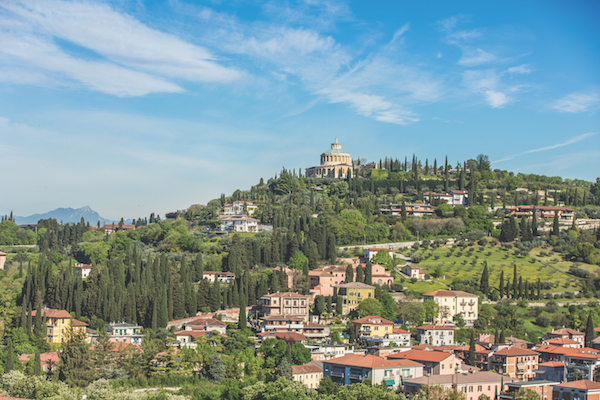
Asymmetrical arches
Leaving the Duomo and the Piazza Vescovado, we quickly reached Ponte di Pietra, the bridge connecting the old city of Verona with Teatro Romano and Castel San Pietro. Built in the 1st century BC, this is the oldest Roman monument in Verona. Its asymmetrical arches and mix of different materials are testiment to the several construction phases and its history.
On crossing the bridge, you arrive in the district of Veronetta. At this point we hesitated for a moment to weigh up whether we had the energy for the steep but short climb towards the Castel San Pietro, but thankfully we made the right call as on reaching the viewing terrace we were presented with some wonderful vistas over the city – a perfect ending and send off to the wonderful city of Verona.
For more Verona ideas, check out Sara’s Verona travel guide
